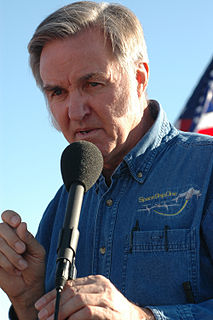
Scaled Composites is an American aerospace company founded by Burt Rutan and currently owned by Northrop Grumman. It is located at the Mojave Air and Space Port in Mojave, California, United States. Founded to develop experimental aircraft, the company now focuses on designing and developing concept craft and prototype fabrication processes for aircraft and other vehicles. It is known for unconventional designs, for its use of non-metal, composite materials, and for winning the Ansari X Prize with its experimental spacecraft SpaceShipOne.

The Rutan Model 76 Voyager was the first aircraft to fly around the world without stopping or refueling. It was piloted by Dick Rutan and Jeana Yeager. The flight took off from Edwards Air Force Base's 15,000 foot runway in the Mojave Desert on December 14, 1986, and ended 9 days, 3 minutes and 44 seconds later on December 23, setting a flight endurance record. The aircraft flew westerly 26,366 statute miles at an average altitude of 11,000 feet (3,350 m).

Elbert Leander "Burt" Rutan is a retired American aerospace engineer and entrepreneur noted for his originality in designing light, strong, unusual-looking, and energy-efficient air and space craft. He designed the record-breaking Voyager, which in 1986 was the first plane to fly around the world without stopping or refueling, and the Virgin Atlantic GlobalFlyer, which in 2006 set the world record for the fastest and longest nonstop non-refueled circumnavigation flight in history. In 2004, Rutan's sub-orbital spaceplane design SpaceShipOne became the first privately funded spacecraft to enter the realm of space, winning the Ansari X-Prize that year for achieving the feat twice within a two-week period.
This is a list of aviation-related events from 1993:

The Mojave Air and Space Port, also known as the Civilian Aerospace Test Center, is in Mojave, California, United States, at an elevation of 2,801 feet (854 m). It is the first facility to be licensed in the United States for horizontal launches of reusable spacecraft, being certified as a spaceport by the Federal Aviation Administration on June 17, 2004. The facility covers 2,998 acres and has three runways.

The Rutan Model 61 Long-EZ is a tandem 2-seater homebuilt aircraft designed by Burt Rutan's Rutan Aircraft Factory. The Long-EZ has a canard layout, a swept wing with wingtip rudders, and a pusher engine and propeller. The tricycle landing gear has fixed main wheels with streamlined spats and a retractable nosewheel. Its predecessor was the VariEze, plans for which were first available to homebuilders in 1976. The prototype Long-EZ, N79RA, first flew on June 12, 1979.

The Laird LC-DW300 and LC-DW500 Super Solution aka "Sky Buzzard" was a racing biplane built in the early 1930s by Matty Laird for the Cleveland Speed Foundation, Laird was already famous in the air racing circuit. It had a large radial engine and an extremely faired windshield. Other than being a biplane, it was similar in appearance to the Gee Bee, a more famous racer from the period. It was an advanced design for the time because of the relatively clean aerodynamic construction and tight engine cowling.

The Rutan Quickie is a lightweight single-seat taildragger aircraft of composite construction, configured with tandem wings.

The Berkut 360 is a tandem-seating, two-seat homebuilt canard aircraft with pusher configuration and retractable landing gear, built primarily of carbon fiber and fiberglass.

The XCOR EZ-Rocket was a test platform for the XCOR XR-4A3 rocket propulsion system. The airplane was a modified Rutan Long-EZ, with the propeller replaced by first one, then later a pair of pressure-fed regeneratively cooled liquid-fueled rocket engines and an underslung fuel tank. The engines were restartable in flight, and were contained within Kevlar armor shielding. The EZ-Rocket was registered as an experimental aircraft.
The AMSOIL Racer, also known as the Rutan Biplane Racer and the Rutan Model 68 Racer, was a race tandem wing plane which was designed by Burt Rutan's Rutan Aircraft Factory, and built and flown by Dan Mortensen. It set several speed records, but crashed at the 1983 Reno Air Races.

Rare Bear is a highly modified Grumman F8F Bearcat that dominated the Reno Air Races for decades.

The Folkerts SK-2, also known as Speed King Two, "Toots" and "Miss Detroit" was a racer built for the 1936 National Air Races

The Red Baron was a North American P-51D Mustang NX7715C, original serial number 44-84961. It raced from 1966 to 1973 under the names Miss R.J. and Roto-Finish Special, winning Unlimited Gold in 1972. In February 1974, it was purchased by Ed Browning of Red Baron Flying Service in Idaho Falls, Idaho and renamed the Red Baron.
The Scaled Composites Model 367 BiPod is an experimental flying car developed by Scaled Composites. It was the final aircraft designed by Burt Rutan prior to his retirement.

The Wedell-Williams Model 22 was a racing aircraft, two examples of which were built in the United States in the early 1930s by the Wedell-Williams Air Service Corporation. It was one of three early projects by aircraft designer Jimmy Wedell to create a racer and was built specifically to compete in the 1930 All-American Flying Derby from Buffalo to Detroit. It was a braced, low-wing monoplane originally powered by an inline Cirrus engine and equipped with fixed landing gear in large spats.

The Quickie Q2 or Q2 is a two-seat version of the unique Rutan Quickie, produced in kit form by the Quickie Aircraft Corporation founded by Tom Jewett and Gene Sheehan. Canadian Garry LeGare was involved in the design.

The Fahlin SF-2 Plymocoupe was a high-wing, cantilever type, prototype experimental airplane produced in 1935.

The Rutan SkiGull is an amphibious aircraft designed by Burt Rutan.

Precious Metal is a custom-built racing aircraft based on the North American P-51 Mustang.

















